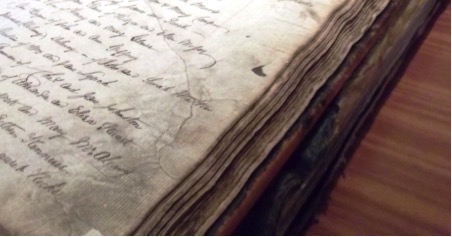ORIGINS: the ancient parish of Shankill comprised the entirety of modern-day Belfast. Its first early Christian church was situated in the disused cemetery on what is now the Shankill Road. In the 1306 taxation of Pope Nicholas, raised to fund the Crusades, it is titled ‘The White Church of Shankill’. Later it appears that the church became redundant but its title and functions were transferred to a church built close to the ford across the Lagan River and the Norman castle. The Terrier of 1615 lists church property confiscated at the Reformation and names this church, ‘St Patrick’s Church of the White Ford’.
raised to fund the Crusades, it is titled ‘The White Church of Shankill’. Later it appears that the church became redundant but its title and functions were transferred to a church built close to the ford across the Lagan River and the Norman castle. The Terrier of 1615 lists church property confiscated at the Reformation and names this church, ‘St Patrick’s Church of the White Ford’.
English Protestant settlers, who acquired the church, rebuilt it in 1812 renaming it in honour of St George, the patron saint of England. Catholics reclaimed the ancient title for the church built in Donegall Street by dedicating it to St Patrick, patron saint of Ireland.
The foundation stone of the current church was laid by Bishop Patrick Dorrian on 18th of April, 1875. During his ministry as the Bishop of Down and Connor (1865-85) twenty six new churches were built. St. Patrick's was built in the Romanesque style of different coloured sandstone. Bishop Dorrian was buried beneath the sanctuary behind the priest’s chair, marked out by a thin line of red marble. In the left transept, adjacent to St. Joseph’s Columbarium, is his memorial, rendered in sandstone and alabaster, and it bears the arms of the Diocese of Down and Connor.
A CHURCH WITHIN A CHURCH: a previous church, built on this site in 1815, no longer sufficed for the increasing congregation. To accommodate them during the construction of a new and larger church, Messrs Collins Brothers of Portadown commenced building the new church around the old. It was then demolished in August, 1876 and the entire fabric of the new church was speedily completed for blessing on 12th of August 1877 by the Primate of All Ireland, Archbishop Daniel McGettigan of Armagh. A two-ton bell, cast by Thomas Sheridan of Dublin, had already been placed into the 180 feet high (54 metre) spire. Thomas Heanvey, the architect of the splendid new church, had been a former associate of Augustus Welby Northmore Pugin and like him did not brook delays.
Inside the church, ten beautiful arches of red sandstone, supported by slender rose and grey Dumfries granite pillars separate the nave from each aisle. Three further arches separate the sanctuary from the nave. As the eye traces the orbit of the 50 feet (15 metre) high centre arch, it comes to rest on the pitch pine ceiling.
REREDOS AND ALTARS: behind the altar versus populum, made of Portland stone and installed in 1997, stands the original high altar with its reredos of Caen stone, relieved by Cork red and Galway green marble columns. The reredos together with its sculptures was the work of O’Neill and Pearse of Dublin as was the Portland stone statue of St. Patrick outside in the tympanum over the main front doors.
REFURBISHMENT AFTER THE 1995 FIRE: after a catastrophic fire on 12th of October, 1995, every effort was made to restore the church to its original state by the then Administrator, Very Rev David White, and his project manager, Mr Oliver Magill. To repair the reredos and its tabernacle, old sketches and photographs were consulted. After a long, costly and painstaking restoration project, he church was reopened by Bishop Patrick Walsh on 5th of October, 1997.
SHRINE OF MARY AND BAPTISTERY: left of the sanctuary is the modern shrine of Our Lady of Comfort, designed and cast in bronze by sculptor, Mr Chris Ryan of Howth, in 1997. Mary’s Son is held out to us as Saviour while a lady, representing the parish, seeks patronage. On the right is the baptistry whose font commemorates, on seven of its eight sides, the grace giving sacraments established by Christ. An aumbry adjacent to the font contains the Holy Oils used in the administration of the Sacraments.
STAINED GLASS WINDOWS: to beautify the church stained glass windows were added over time. High in the apse seven windows depict the Lord Jesus with his saints in glory. A rose window in the Shrine of Mary represents the Magi visiting Bethlehem while in the baptistry another rose window portrays Jesus revealing the love of his Sacred Heart for all people to St Margaret Mary Alacoque. Four windows in the left transept, reinstalled from St Kevin’s Church in North Queen Street before its demolition, represent the Holy Trinity. The original windows in the right transept were destroyed as a result of an explosion during the recent years of sectarian conflict, but the six windows now installed illustrate the life and apostolate of St Patrick. It is noteworthy how often Mary the Mother of God is depicted, under different titles in the remaining stained glass windows of the nave.
NAVE SHRINES: a shrine on the right is dedicated to St. Anthony of Padua; there is a first class relic of the saint in the reliquary on the left side of the statue. The triptych altarpiece on the left of the nave was presented in 1917 by the renowned painter Sir John Lavery, in memory of his baptism in the previous St. Patrick's Church on 26th of March, 1856. His second wife, Hazel Trudeau was the model for the Madonna while St. Patrick and St. Brigid were modelled by his daughter Eileen and step-daughter Helen respectively. All of Lavery’s letters to the then Administrator, Fr O’Neill, are preserved in the parish archive. They give great detail of the original setting of this work including the side altar and furnishings commissioned from the great architect, Sir Edwin Lutyens. The original setting was sadly lost in reordering works carried out in the 1960s and 70s and all that remains of Lutyens’ fine work is triptych frame, adorned with Celtic knotwork.
RELIQUARIES: the church holds a large collection of relics of saints, most notably two relics of St Patrick. The priceless silver reliquary which holds the arm relic of the national patron was fashioned in the 14th Century and is presently on loan to the Ulster Museum. Meanwhile, the silver reliquary, fashioned in 1645, containing the jaw bone of St. Patrick, is on loan to the Down County Museum in Downpatrick.
